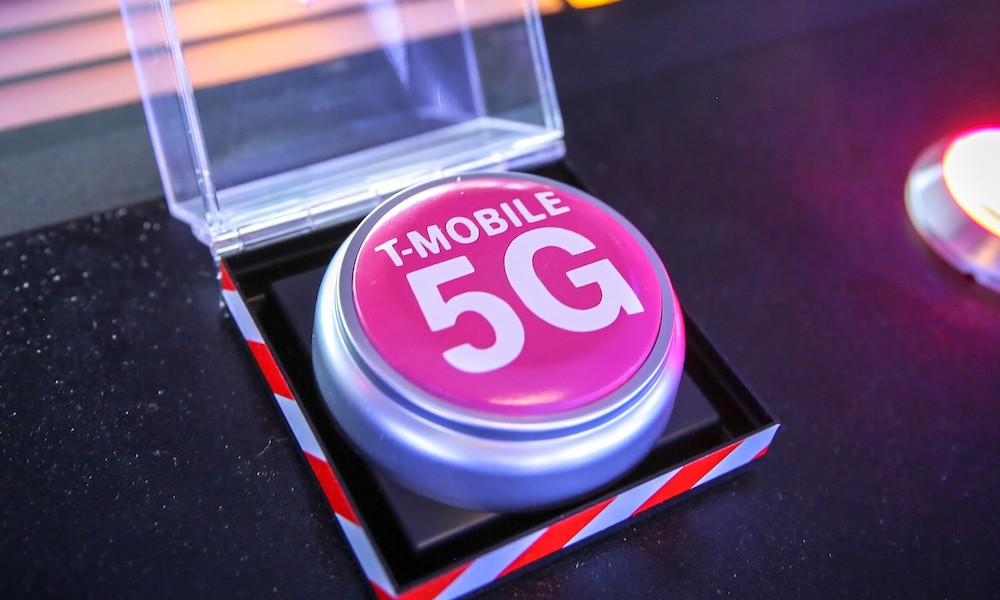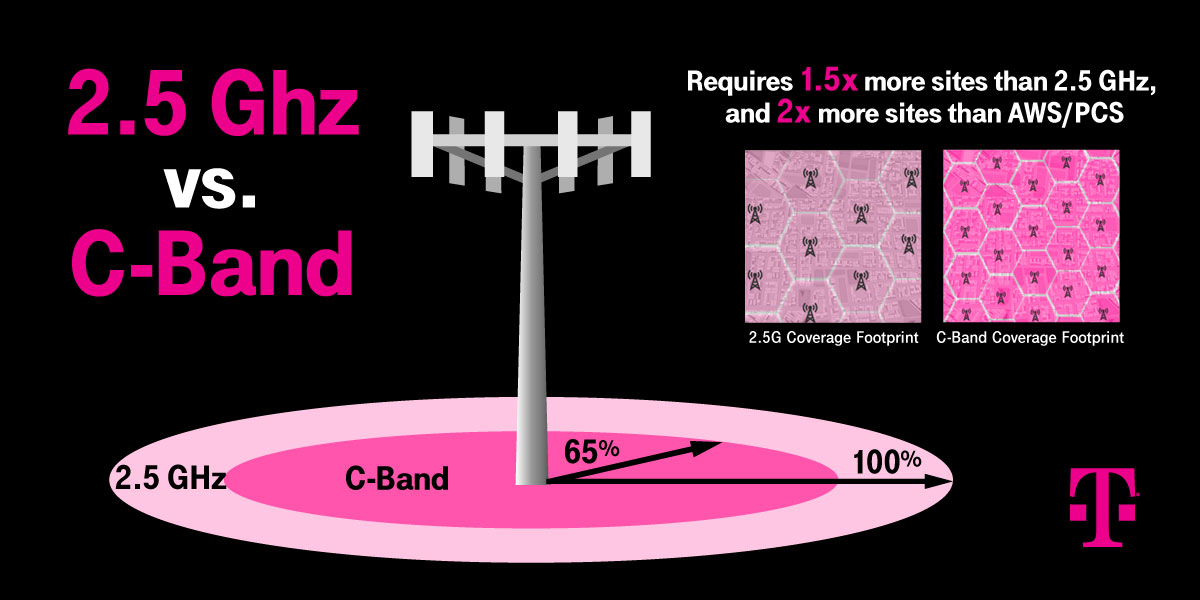T-Mobile Is Seriously Upping the Stakes in the 5G Game
 Credit: T-Mobile
Credit: T-Mobile
Toggle Dark Mode
While its rivals are still playing catch-up to T-Mobile’s zippy nationwide 5G network, the “Un-carrier” isn’t sitting still either, with plans to push 5G speeds and coverage to a whole new level.
Although, technically speaking, Verizon has the fastest 5G technology in play right now in the form of its UWB mmWave network, the coverage provided by that network is so limited that it’s irrelevant for most 5G iPhone users.
Most estimates suggest that a mere 5 percent of Verizon 5G users are fortunate enough to live within range of an mmWave transceiver, meaning the other 95 percent of Verizon customers are stuck with the company’s substandard DSS 5G — a network that provides speeds that are no faster than 4G LTE, and sometimes even slower.
So, it’s no surprise that T-Mobile’s 5G already runs circles around both Verizon and AT&T, since it’s actually built a “true” 5G network across the U.S., while the other carriers are simply relying on leftover scraps of 4G frequencies to carry their 5G network.
Although Verizon has already dropped a massive wad of cash in an effort to improve the situation, most analysts are suggesting that’s not going to bear fruit until 2022, and to add insult to injury, it looks like Verizon plans to make customers pay more to get real 5G speeds.
Onward and Upward
By that time, however, T-Mobile plans to be even farther ahead of the game. In a virtual analyst event held this week, T-Mobile announced that it’s also grabbed its own chunk of “C-band spectrum” — from the same block that Verizon just spent a record $45 billion on — and it plans to put it to good use enhancing its own 2.5GHz spectrum.
We’re honored to already serve Americans with the largest and fastest 5G network in the country, just as robust wireless connectivity has become more important than ever … but we’re not letting off the gas.
Mike Sievert, T-Mobile CEO
Even though T-Mobile only spent a little over $9.3 billion for the new spectrum, it arguably doesn’t need as much, as it already has a pretty sizeable amount under its belt — to the point where AT&T accused it last year of “hoarding 5G spectrum.” Meanwhile, AT&T dropped $23.4 billion for its own piece of the C-band pie.
Most importantly, however, while T-Mobile originally built out its nationwide 5G network using the lower 600MHz frequencies, it also acquired a considerable chunk of 2.5GHz spectrum thanks to its merger with Sprint last year.
T-Mobile did initially decommission most of the Sprint towers after the merger, however that was just to free up that spectrum, so it could eventually roll it out again properly, and by last fall it had covered over 410 cities with its new “goldilocks” 5G spectrum that offered the perfect balance of coverage and speed.
You see, just like Wi-Fi networks, there’s an inverse relationship between coverage and speed when it comes to frequencies. T-Mobile’s 600MHz network allowed them to easily cover all 50 U.S. states with a minimum number of towers, but provided speeds that were only slightly better than 4G LTE. Moving up into the 2.5GHz frequencies allows for faster speeds at the cost of range, but it’s also the key to getting true 5G performance — at least in the sub-6GHz band.
By contrast, Verizon’s ultra-fast mmWave lives up in the 29GHz and 38GHz range, offering blazing-fast speeds that can reach 4Gbps, but having the range of a single city block.
T-Mobile has since begun calling this 2.5GHz mid-band service the “Ultra Capacity” network, while the slower 600MHz service is referred to as “Extended Range.”
At this point, the company already boasts Ultra Capacity coverage of around 125 million people, with the Extended Range covering 287 million. However, T-Mobile just announced that by the end of next year, 97 percent of Americans will have Extended Range coverage, while it plans to have Ultra Capacity service available to 90 percent of Americans — or about 300 million people — by the end of 2023.
Further, with the new C-band spectrum that it just acquired, T-Mobile plans to boost Ultra Capacity 5G speeds from 300Mbps to 400Mbps, since the higher 3.5GHz frequencies in the C-band offer even more bandwidth. In fact, T-Mobile obliquely contrasted its relatively humble $9.3 billion expenditure with Verizon’s big splurge, noting that it was a strategic acquisition to enhance its existing 2.5GHz 5G coverage.
That said, the carrier also acknowledges that the new spectrum is going to require 50 percent more cell sites and up to 4x higher in-building density compared to its current 2.5GHz Ultra Capacity service, but it still expects to allow it to pull farther ahead than its rivals, who it says started off on the wrong foot by embracing mmWave.
Simply put, Verizon and AT&T bet on the wrong horse — went all in on millimetre wave — and now they’re scrambling … and writing big checks … to try to catch up.
Neville Ray, President of Technology, T-Mobile
While Verizon’s boasts of 4Gbps 5G speeds may sound impressive on paper, there are very few mobile users — if any at all — who can actually make any real use of these kinds of speeds. After all, Apple TV+ has the highest bitrates of any streaming video service, and even that only peaks out at 40Mbps.
Ultimately, 5G speeds are like megapixel counts — higher numbers may sound better, but there’s a point at which they don’t make any practical difference — especially if they can’t even reach you in the first place.








